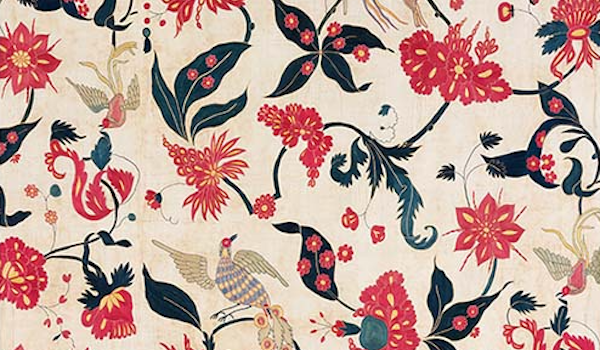
Fabric Of India

With the V&A's Fabric of India exhibition on tour and opening at the Cincinnati Art Museum this week we thought we'd take a look into our archives at curator Rosemary Crill's highlights from the exhibition. As published in the India issue of Selvedge.
India is the quintessential land of textiles. From the humblest hand-woven sari worn in a remote village, to glittering gold-thread embroideries for a maharaja’s palace, the range of fabrics made and used in India over centuries is truly astonishing.

Traditionally, woven textures and dye effects have been valued in India as much as, sometimes more than, costly materials, and this appreciation of cloth in all its forms is what makes India’s textiles so rich and varied. They are familiar to us in myriad ways; many of us have block-printed cottons, pashmina shawls and mirror-work embroidery somewhere in our homes – but we scarcely scratch the surface of the variety of India’s fabrics.
The Fabric of India is the first exhibition to tackle the ambitious task of presenting a wider view of India’s handmade textiles. Ranging from the old to the new, from the rough to the smooth (and indeed the shiny) and from the everyday to the imperial, this exhibition shows how simple cotton lengths, as well as, elaborate silk and gold brocades were all seen as part of the wealth of India.

A particular aim is to highlight materials and techniques. These basic elements have their own beauty – hanks of silk yarn, cloth dyed red with chay root and lac, soft diaphanous muslin and thick woollen garments are shown alongside iridescent beetle-wing embroidery and cloth woven from silver.
A thread of materials and making runs through the exhibition, but it also explores how these textiles were used and by whom. Village celebrations are evoked in a huge appliqué room-hanging which would have been used for weddings and other festivities. So large that it has been impossible to display until now, this joyful piece has had a chequered history. It was found abandoned on a New York sidewalk by Mr Jerome Burns. who rescued it and took it home. He too had nowhere to store or erect it, so he and his wife offered it to the V&A in 1994. It is wonderful to be able to show it at last – it is only sad that Mr and Mrs Burns are no longer with us to see it.

Textile ‘architecture’ of this kind is found throughout India. Canopies, fabric screens and even whole tents are used for outdoor gatherings and decorated in different ways according to the region in which they are made, used and the level of patronage available to their owner. The appliqué roomsetting is in the same tradition as the beautiful floral tent owned by Tipu Sultan of Mysore, which is also on show and gives an idea of the lavish surroundings enjoyed by Indian rulers even when on the move, on campaign or a day out. Royal tents would be beautifully furnished with decorative floor-covers and wall-hangings, just as in a permanent palace.
Textiles made for rulers or wealthy patrons were not necessarily the most ostentatious. While we often associate the maharajas of the 19th century with heavily encrusted garments covered with gold-thread embroidery, the taste of earlier rulers was much more subtle. They often valued fine materials such as Bengali muslin or undyed Kashmiri shawls over lavish decoration, even if those simple but exquisite materials might be teamed with a necklace of huge pearls or diamonds.

Mughal paintings often show the emperors and their courtiers with shawls draped around their shoulders. Originally in undyed natural white or brown tones, Kashmiri shawls only started to be decorated in the 17th century, with a simple row of flowers at each end: these evolved into the stylised floral motif called the buta or boteh. Widely imitated in Britain and France it became known to us as the Paisley pattern, obscuring its Indian origins.

India’s textiles have been sent abroad to foreign buyers for many centuries, and one of the great skills of the Indian makers was in adapting techniques and designs to suit each market’s taste and demands. This extended to the feel and even the smell of some export textiles – if the ikat telia rumals from South East India did not have the right smell and oily texture it meant that the traditional processes of steeping the cloth in gingelly oil (a type of sesame oil) prior to dyeing had not been carried out, and the cloth would be rejected by consumers in the Middle East and West Africa. The flower-patterned cottons which came to be known as chintz in the West used the same techniques of resist and mordant-dyeing as textiles made for local South Indian patrons, but with different designs.
The hand skills of India’s textile makers have been undermined since the early 19th century but designers and independent organisations are working to ensure their survival. Today contemporary Indian designers continue to adapt and re-fashion traditional techniques: like this exhibition, they are inspired by the past while looking to the future.
The Fabric of India
October 19, 2018–January 6, 2019
For past issues of Selvedge visit our back issues page.
